Learning Croatian: How Do People from Hvar, Dubrovnik Understand Each Other?
February 5, 2021 - Croatia is a country full of dialects. How do the people of Hvar and Dubrovnik understand each other, for example? The latest Hvar dialect lesson from Professor Frank John Dubokovich.
My Croatian is by no means fluent but I get by pretty well and am happy to do television interviews in Croatian, for example (much to the amusement of locals), but when I moved from Hvar to Varazdin four years ago, I thought I had entered a different country. The Varazdin dialect was REALLY hard to follow after being brought up on Dalmatian.
Things are a little better these days, but I still struggle a lot, and I do look in wonder at my kids who switch effortlessly between the two during the school holidays back in Jelsa.
The dialects of Croatia have fascinated me, even since we started a fun Hvar dialect video series with the self-styled linguistic colossus, Professor Frank John Dubokovich back in 2011. His iconic Dalmatian Grunt, above, took the Internet by storm, quickly racking up 50,000 views before the channel was removed by YouTube for reasons unknown.
We are now reintroducing some of the original videos which I came across offline last year. As the series developed, we invited people visiting from other parts of the country to take part, so that we could compare the dialects of Hvar and that region with the classic Croatian dialect.
In the latest episode, we were delighted to welcome a Dubrovnik resident to the Total Office in Jelsa, and we put The Professor, our Dubrovnik guest and classic Croatian speaker through their paces with a range of phrases to highlight some of the differences.
It is hard for me as a foreigner to recognise that they are all speaking the same language. How about you?
For more linguistic genius from Professor Frank John Dubokovich, Guardian of the Hvar Dialects, subscribe to the YouTube channel.
Learning Croatian: the Hvar Dialect Language of Love
January 30, 2021 - Visiting Hvar and looking for the perfect language of love? Help is at hand in the latest in our Hvar dialect series with Professor Frank John Dubokovich.
Within a week of moving to Hvar all those years ago, I had met the girl of my dreams in the library in Jelsa and have been married to her for many years now. As such, I have never had any need for the language of love, Hvar-style, that is the focus of this week's lesson in Hvar dialect from Professor Frank John Dubokovich, Guardian of the Hvar Dialects.
The Professor, you may recall, became an Internet sensation several years ago when his iconic Dalmatian grunt was unleashed on an unsuspecting public, quickly racking up over 50,000 views before YouTube removed it for reasons unknown.
The Professor is the most successful man with the ladies I have ever met on all my travels to almost 100 countries in my 51 years, and while it is tempting to assume the Dalmatian grunt instantly melts female hearts, it turns out that the Professor has a whole arsenal of Hvar dialect terms dedicated to the language of love.
In this week's episode, which was recorded in early 2013 and is now once more back online, the Professor is joined by Hvar tour guide Dijana Moskatelo, whose classic Croatian phrases of the language of love seem to be a lot more comprehensible than the Professor's utterances. But who am I to judge?
If you would like to learn more about the dialect words spoken on Hvar, we are slowly restoring the popular series from the early days of Total Hvar to YouTube. You can subscribe to the TCN Talks YouTube channel for the latest updates.
For the latest news from Hvar, check out the dedicated TCN section.
Learning Croatian Vegetables the Hvar Dialect Way (VIDEO)
January 23, 2021 - Continuing our alternative look at the Croatian language through Hvar dialect, this week Professor Frank John Dubokovich shows us his moves in the mysterious world of learning Croatian vegetables.
I sometimes wonder how Croatians from other parts of the country understand each other. I know that all countries have dialects and dialect words, but Croatia seems to take the regional vocabulary to a different level.
One of the fun projects in the early years of the Total Project, before TCN, was an occasional language series on Total Hvar looking at the Hvar dialect compared to standard Croatian with Professor Frank John Dubokovich, Guardian of the Hvar Dialects.
What started out as a bit of fun with the infamous Dalmatian Grunt in the first episode above, quickly got quite a following, with more than 50,000 views for that first article. About 20 more videos followed until they were taken down by YouTube for reasons unknown.
We continue to restore the Professor's linguistic colossus to the Internet with the latest in the series, a rather illuminating look at the differences in various words on the subject of vegetables and how they differ between standard Croatian and Hvar dialect.
The Professor confessed to me before shooting this lesson that there was something about the Hvar dialect word for 'aubergine' that made his want to get up and dance. He was even kind enough to demonstrate some of his moves during the lesson.
With thanks to Zdravko for his more understandable version for those learning Croatian vegetables, as well as to Marion in her role as Executive Aubergine Holder.
You can follow more of the linguistic musings of the Professor as the series develops by subscribing to the TCN Talks YouTube channel.
For the very latest from the island of Hvar, follow the dedicated TCN section.
Hvar Clock Tower Gets New Attire, Soon Welcomes Its First Visitors
January 21, 2021 - The renovation of the Hvar clock tower, the so-called Leroj from the 15th century, is close to its completion. Once all works are finished, it will open to visitors for the first time.
In the final stage of renovation that started in 2016, the interior of the Hvar clock tower Leroj (meaning hour, clock), finally takes on a new look and acquires a new user value. Located in the very center of Hvar town, along with the city loggia, the clock tower is the only preserved part of the Governor's Palace complex. It was demolished in the early 20th century due to the Empress Elizabeth Hotel's construction, today's Palace Elizabeth Hotel, the first five-star hotel on Hvar.
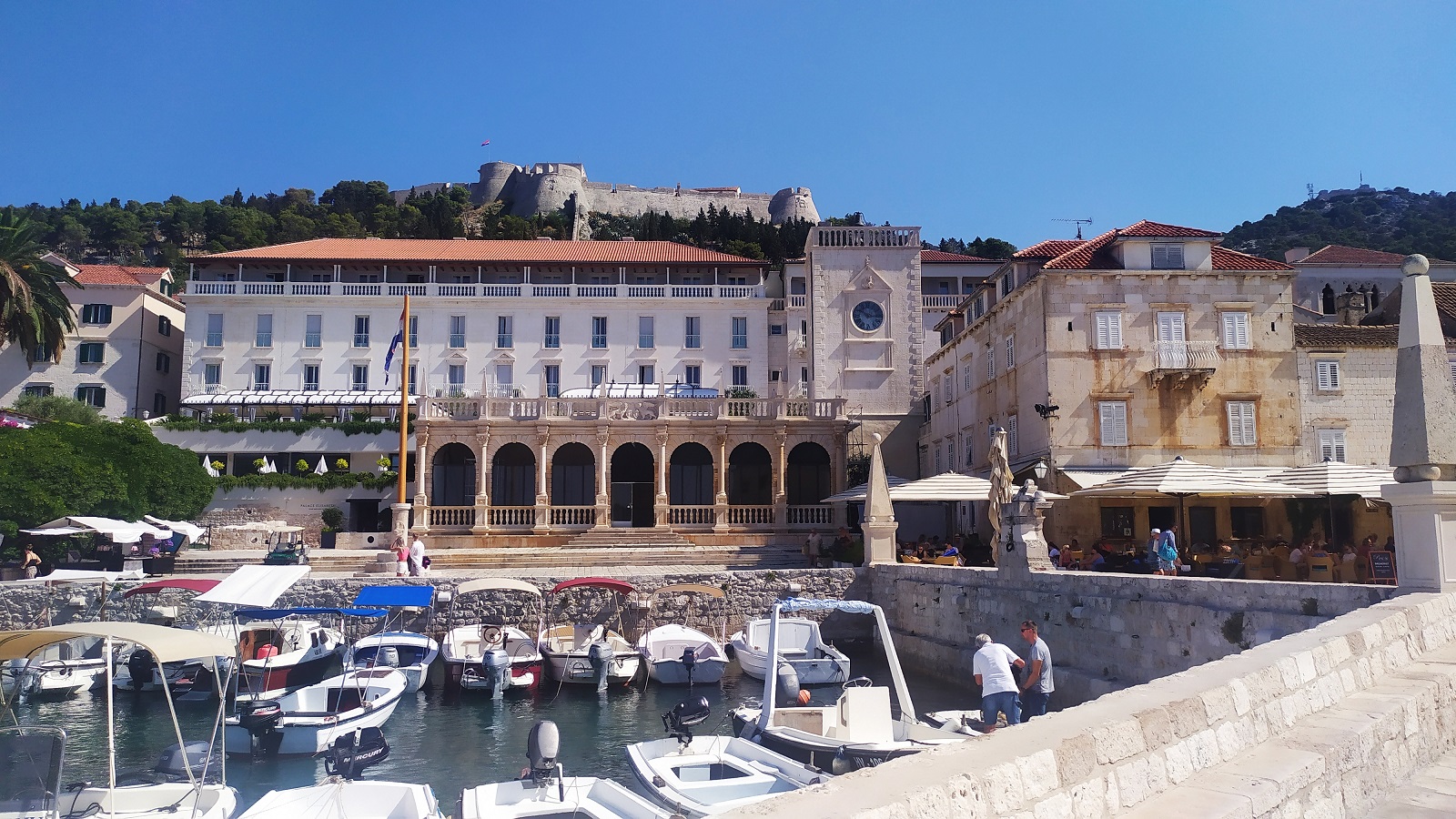
Palace Elizabeth Hotel, city loggia, and clock tower in the very center of Hvar / Donatella Pauković
As reported from the City of Hvar, after the completion of works on constructive repairs (according to the project of the engineering bureau Kulić from Split), the works on the interior decoration continued according to the project of the authorized architect Branka Petković.
As part of the project, a hitherto non-existent and much-needed infrastructure was introduced – electricity, water, drainage (sanitary facilities), and the internal walls were arranged. New mezzanine constructures were installed, connected by a complex suspended metal staircase with a continuous panel made of perforated sheet metal.

Facebook Hvar Town
The Hvar clock tower now received an exit to the roof terrace paved with stone, just like the ground floor, which has a new entrance door and glass walls.
The original bell from 1564 has been restored. Final works also include installing wooden floor coverings, final varnishing of all metal parts of the interior and staircase, installation of decorative interior lighting, and restoration of the original clock mechanism from the 19th century. The company Neir from Split performs constructive renovation and interior decoration works.
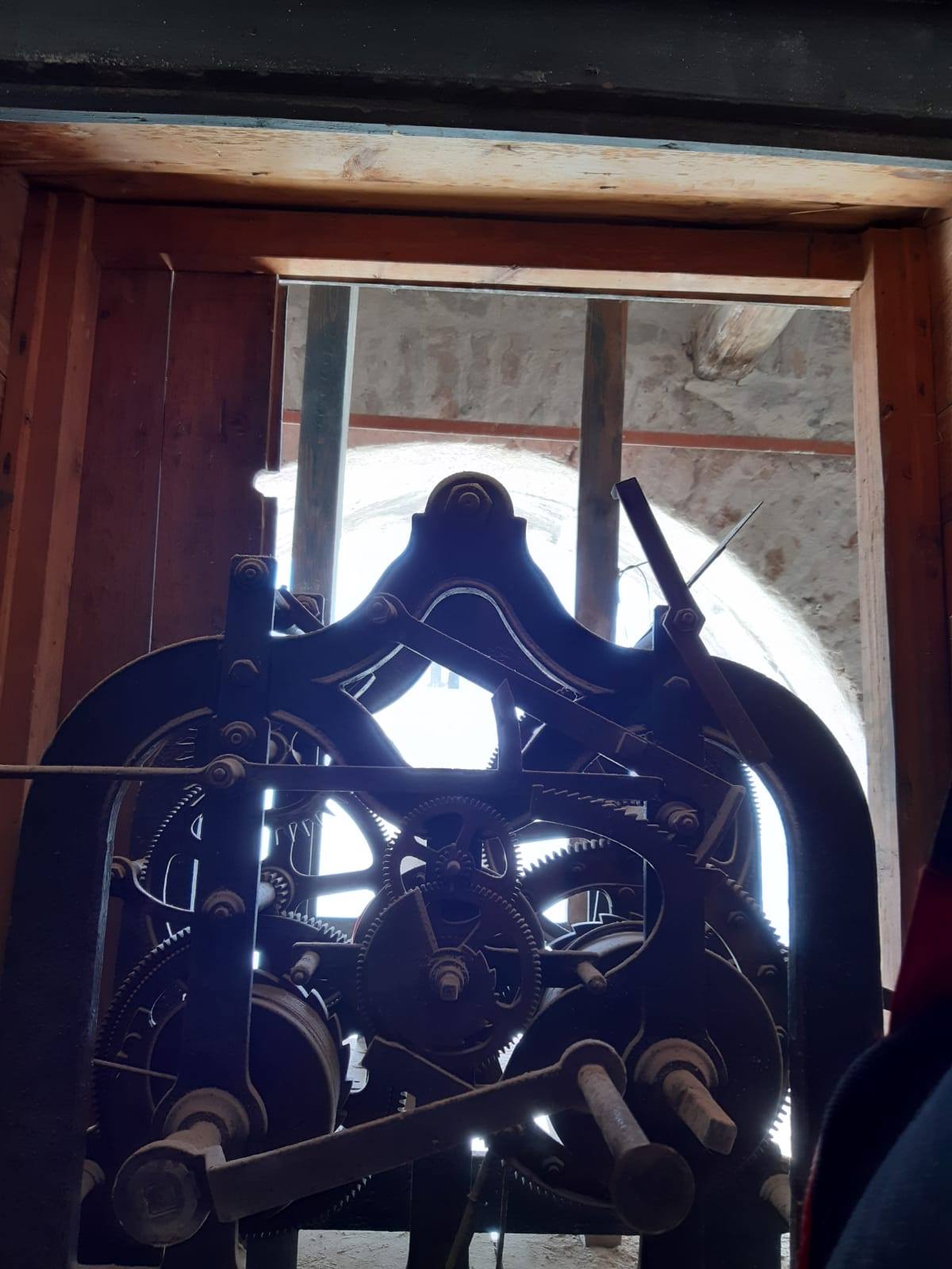
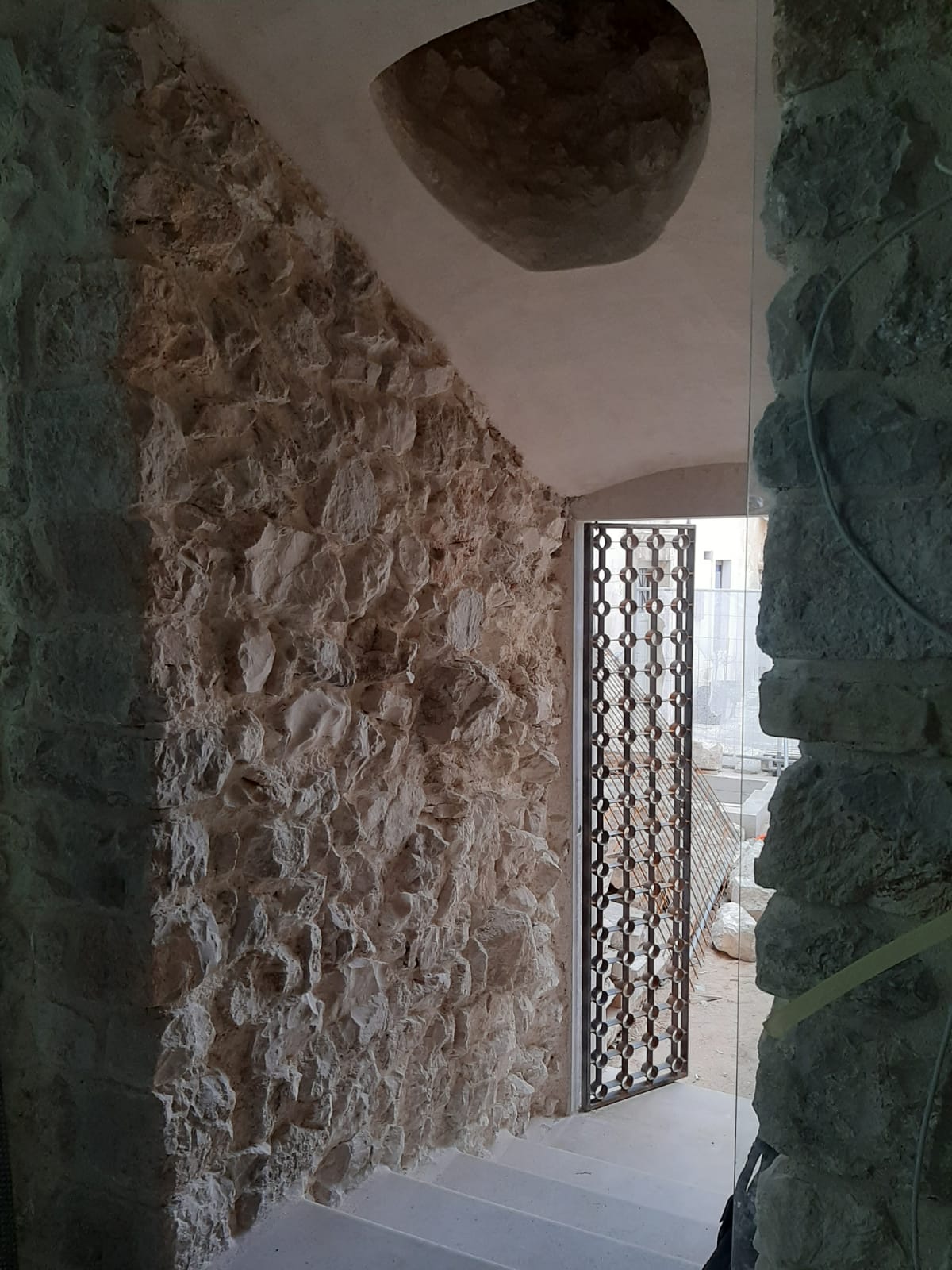
Facebook Hvar Town
The square clock tower built east of the city hall loggia was initially part of the Rector's Palace's defense system within the medieval southern walls. In 1564, it was converted into a tower – leroj – by installing a public city clock and bells. It was last restored in 1903, and after the completion of all works, it will be open to visitors for the first time.
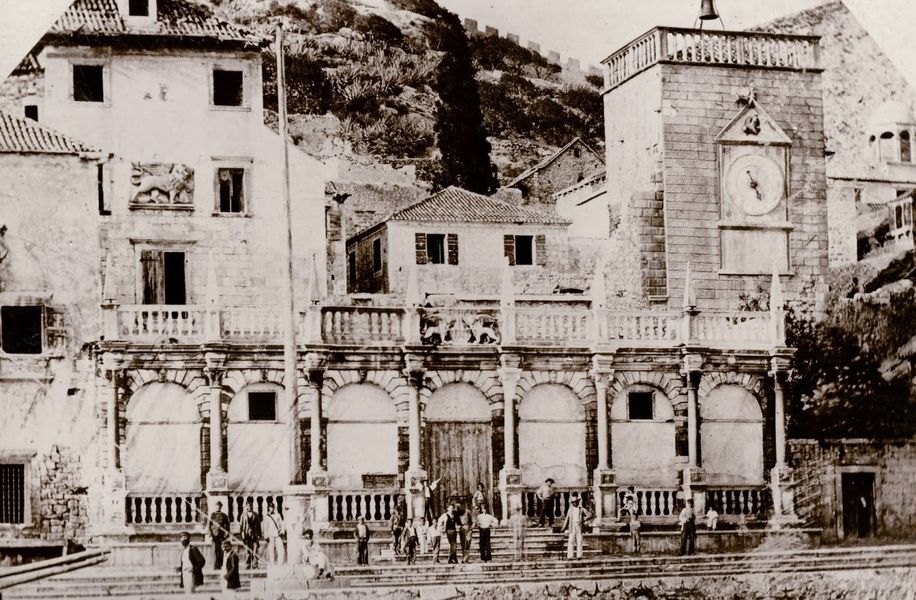
Facebook Hvar Town
For the latest travel info, bookmark our main travel info article, which is updated daily.
Read the Croatian Travel Update in your language - now available in 24 languages.
Hvar Arsenal Presented in Prestigious European Online Magazine
January 13, 2021 – On the occasion of receiving the prestigious recognition of the European Heritage Awards 2020, a large article about the famous Hvar Arsenal, the most important public building in Hvar, was published in the renowned European Diplomacy & Economics Online Magazine.
As reported by Branimir Tončinić, Croatian National Tourist Board Director in Austria, the publication was created due to cooperation between the CNTB Representation in Austria, the Hvar Tourist Board, and the magazine's editorial board.
The announcement states that Hvar Arsenal is the winner of the Europa Nostra award, the most prestigious European award in the field of heritage, which the European Union has been awarding since 2002. This year, the award was given to 21 projects from 15 countries, and Arsenal is the winner in the conservation category. Recognition was given for the restoration and strengthening of the load-bearing structure of the Arsenal. Given the current situation, this year's awards ceremony was held virtually for the first time.
The Arsenal building, located in the center of Hvar town, the most important port on the island, has been carefully restored and successfully transformed into a living cultural center for visitors and the local community. The Croatian Ministry of Culture and the Ministry of Regional Development and European Union Funds were partners to the City of Hvar in the 30-year project of the Hvar Arsenal reconstruction, which ended in 2019.
An independent jury, made up of heritage experts from across Europe, selected the award winners, following a detailed evaluation of the nominations submitted by organizations and individuals from 30 European countries.
"This valuable revitalization project has adapted a significant building to the modern needs of the community and added a new cultural dimension to the tourism of this area. It represents a long-term effort to ensure Arsenal preservation as a site of high cultural heritage. The stratification of the 16th-century building and later 18th-century theater has been properly recognized in conservation work. Such localities are proof of international trade's long history in Europe, and their location in the port is significant, where they still play an important role as a place of connection," said the jury.
European Diplomacy & Economics is a magazine intended for professionals in diplomacy and a wider audience throughout the European Union. It covers economics and culture, is published twice a year in 10,000 copies, and is headquartered in Vienna.
To read more about lifestyle in Croatia, follow TCN's dedicated page.
Learning Croatian: the Dialect Words of Hvar Wine (VIDEO)
January 10, 2021 - Continuing our alternative look at the Croatian language through Hvar dialects, some essential vocabulary relating to Hvar wine.
One of my favourite features over the last ten years writing about Croatia is a language series we started soon after the launch of Total Hvar way back in 2010.
Sitting in The Office in Jelsa one quiet November lunchtime, I decided to film my friend with some typical Dalmatian greetings.
The unique phenomenon that is the Dalmatian Grunt hit the Internet and a new online start was born. The linguistic colossus that is Professor Frank John Dubokovich, Guardian of the Hvar Dialects, quickly amassed 50,000 views on YouTube, and a fascinating series of lectures followed, until they were inexplicably removed from YouTube a few years ago.
Thankfully, I came across some of the offline originals recently and have been publishing them again.
Today's lesson focuses on the dialect words for Hvar wine. In some ways, it is a landmark lesson, since it was the first to be independently commissioned by someone else.
The Professor's fame had spread so far that national television came calling, and they requested that we record an exclusive lesson for them about Hvar wine for a forthcoming primetime feature on tourism in Jelsa.
The Professor was eager to please and was eager to expand his ever-expanding flock. We thought that the best place to record was at Artichoke Wine Bar and Restaurant in Jelsa, which became the first place the island to offer Hvar wine by the glass soon after it opened several years ago.
You can check out the Professor's latest foray into the world of Hvar wine above, as well as checking out the entire feature on Jelsa, the only time in my life I have ever been recorded eating blitva.
You can catch up with The Professor's teachings on our TCN Talks YouTube channel.
For more news from Hvar, check out the dedicated TCN section.
Island in Flames by Miki Bratanic: On This Day in 1943 in Vrbanj on Hvar
January 3, 2021 marks the 78th anniversary of a devastating day for two villages on the island of Hvar, the subject of Miki Bratanic's latest book - Island in Flames.
When I first visited the village of Vrbanj on Hvar back in 2003, I was struck by how many ruins there were in such a living village. Indeed, as I learned, Vrbanj is the biggest village on the island, with over 400 inhabitants. It was only years later that I learned the reason why. For back in 1943, on this very day, the occupying Italian forces burned most of the houses in Vrbanj. Many lay ruined for decades until at least some were renovated after the property boom of 2003-5, as foreigner buyers snapped up enchanting stone ruins on an idyllic Adriatic island. Almost all of them without knowing the reason their new purchases were in such a state of disrepair.
Dalmatian historian and Vrbanj patriot has recorded this troubled period in the island's history with his latest book, An Island in Flames, which is due out shortly.
On this day 3.1.1943. Italian fascists set fire to the villages of Dol and Vrbanj on the island of Hvar. Most of the houses were completely destroyed, and in the middle of winter people were left not only without a roof over their heads, but also without wine and olive oil, the basic source of income from which they lived, which was either spilled or taken away. After that event, a large humanitarian action was launched in Zagreb to collect aid for the victims on the island of Hvar. And many people helped, from ordinary small people, companies, institutions, and municipalities, cities and counties. The rich documentation of the "Committee for Aid to the Victims of the Island of Hvar" from Zagreb, founded by people from the island, preserves, among other things, the payment slip for donations from the city of Vukovar, as well as an interesting list of a ten-member exiled family from Sucuraj.
The Ministry of the Interior and the Ministry of Finance collected aid, both financial and various material forms of footwear, clothing, construction materials, agricultural tools and various other necessities, mostly food, intended for the victims on the island of Hvar.
The board was initially set up to collect so-called aid "Burners" from Vrbanj and Dol victims of the Italian-Fascist arson in 1943, but was of great importance later to the exiles as well from all over the island deported by the German Nazis in 1944.
Among the many requests for help from 1944 there is a list of 25 people from Sucuraj on the island of Hvar who stayed in Šljivoševci, a village in Baranja that belongs to Donji Miholjac, then 53 people in Tiborjevci, then 40 people from various places the island of Hvar who stayed in Šid, 30 people in Brod, and many more them in various other places, mostly in Slavonia.
So this is one big tragic island story, that's why I called it An island on fire, because indeed that flame of war engulfed the whole island.
Thanks to good people, the complete documentation has been preserved on the work of the Committee, so today we can know what the amounts of goods collected and people involved. We also know how they addressed the Committee people from the island of Hvar who were expelled from the island in 1944 and to whom
help was needed, and how their names were preserved in lists and petitions, so this will certainly be a material of interest to many to their descendants or acquaintances.
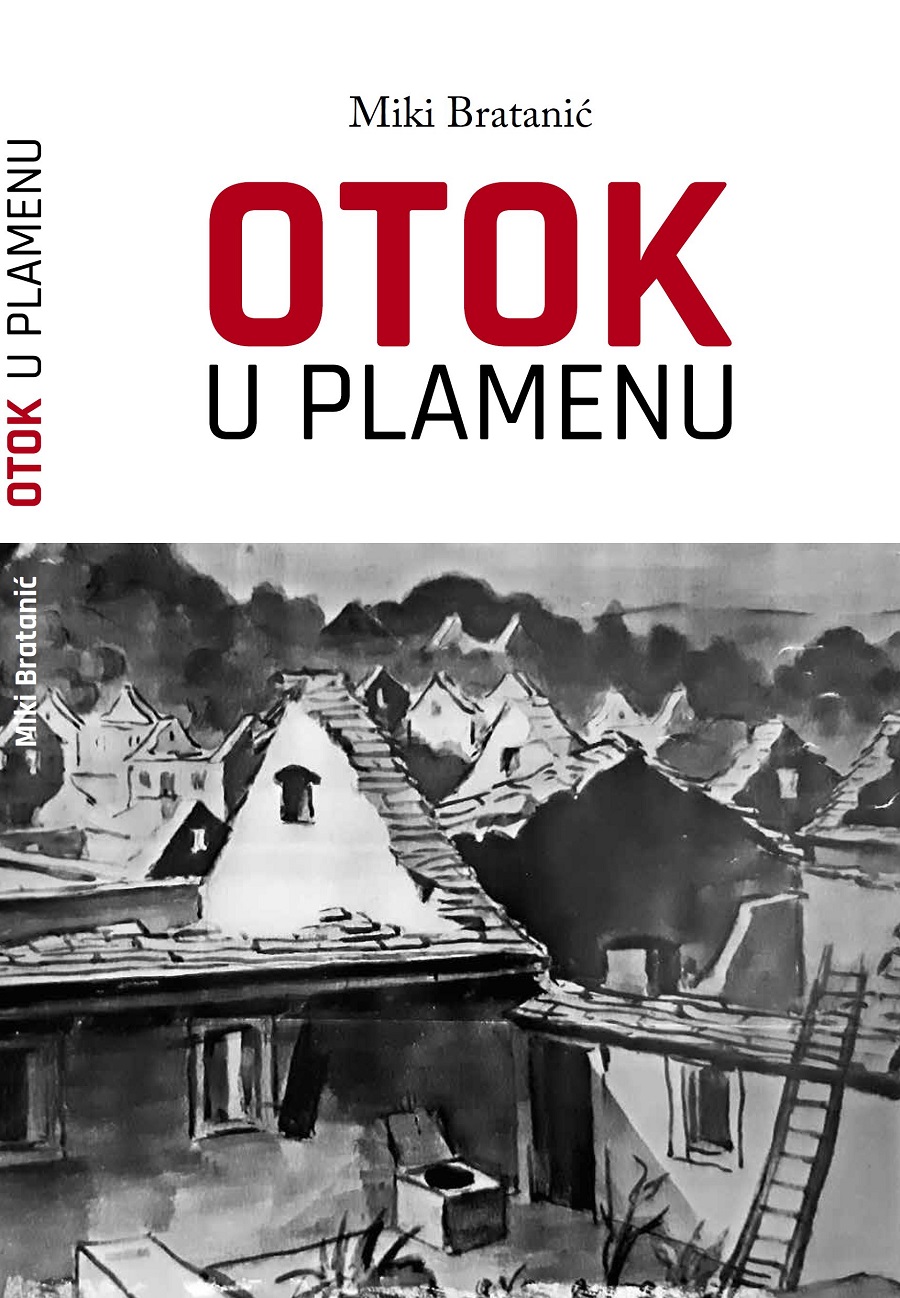
(An Island in Flames, by Miki Bratanic - the painting is by academic painter Bartul Petric, who visited Vrbanj just a few days after this happened).
The first written report on the tragedy of Vrbanj can be found in the telegram the very next day, January 4, 1943, addressed to Bishop Miho of Hvar by the parish priest of Vrbanja, Don Ivo Šeperica:
Yesterday the Italian authorities set fire to the village of Vrbanj, and about 180 houses in ruins, about 60 were rest spared, but the people were left without housing, without food, without suits, without beds and blankets and no money people in a desperate state of food. Send everything to Vrbanj so that the people do not suffer report the matter to the county authority let them stand up for the people regarding food. Also, you should know there are two victims so far.
The initiation of assistance at the highest state level was encouraged by the bishop Hvar's Miho Pušić in a letter sent on January 7, 1943 to the Ministry of the Interior, in which he reports on the difficult situation on the island of Hvar and begs for help. On the same day, Bishop Pušić sent a telegram to the then Archbishop of Zagreb Alojzije Stepinac, asking him for personal engagement and warning in a special way how the Italian military authorities threatened to destroy the entire island if any of their soldiers are killed.
The rest is history, recorded in a hundred documents that are here find to witness one great tragedy, but also one great one humanitarian action that our island of Hvar may never have in history did not experience. Many will be able to find their family in them a story, or an example of what kind of people we have to be in difficult times.
An Island in Flames will soon be available. For the latest news on how to get it, as well as more from the fabulous Miki Bratanic, check out his official website.
New Promo Video for a Very Old Town: Meet Stari Grad on Hvar
January 3, 2021 - Its 2400-history is reflected in its name ('Old Town' in Croatian) and a new promotional video - meet Stari Grad on Hvar.
With distance comes perspective.
For 13 years, I viewed the town of Stari Grad on Hvar from a close distance - my beloved adopted home town of Jelsa 8 kilometres away.
Both Jelsa and Stari Grad are located in the centre of the island, less fashionable and less popular than their more glamorous neighbour to the west - Hvar Town.
Jelsa and Stari Grad were similar but different, and both very pleasant places to hang out. As a patriot, of course, Jelsa was the better place to be.
Moving away from the island 4 years ago, perspectives have changed, and so too is Stari Grad.
It is partly the investment in the new hotels we featured recently in The Rise of the Quality Hotel Scene in Stari Grad on Hvar. It is partly the rise in nautical tourism brought on by the extension of the waterfront in the historic old town, which dates back to the arrival of the Ancient Greeks in 385 BC. It is partly due to the town's commendable direction to avoid party tourism and focus on its authenticity, heritage and natural beauty.
Perhaps the changes are due to my perspective only, but I don't think so. In recent years, Stari Grad has seemed to be more at ease with itself as a destination, with great new restaurants opening (several all year), local arts and craft shops rather than cheap Chinese souvenirs, and an ever more diverse tourism offer.
The Stari Grad Tourist Board released a new promo video for the destination a few days ago, which I really liked. And for the first time, I saw Stari Grad for what it has become - a complete destination.
Here is the new video above. I am sure that an English-language version (at least with subtitles - I would be happy to help with this) is forthcoming. But even if you don't speak Croatia while we wait, the footage is excellent.
Looking to learn more about Stari Grad on Hvar? Here are 25 things to know.
Hvar's Polar Donkeys Enjoys 6th Edition of New Year's Day Adriatic Swim
January 1, 2021 - One way to blow away the cobwebs of 2020 and usher in the New Year is to join Hvar's 'Polar Donkeys' on their annual New Year's Day swim, which took place today for the 6th year in a row.
It is known for its temperate climate, so temperate that it was the birthplace of organised tourism in Europe back in 1868, with the founding of the Hvar Health Society for convalescing aristocrats from the Austro-Hungarian Empire.
Its beaches are renowned as some of the finest in Europe, its pristine Adriatic waters hailed as some of the cleanest and most refreshing in Europe.
Which is wonderful in August when the azure waters are heated by the hot Dalmatian summer sun.
But on January 1?
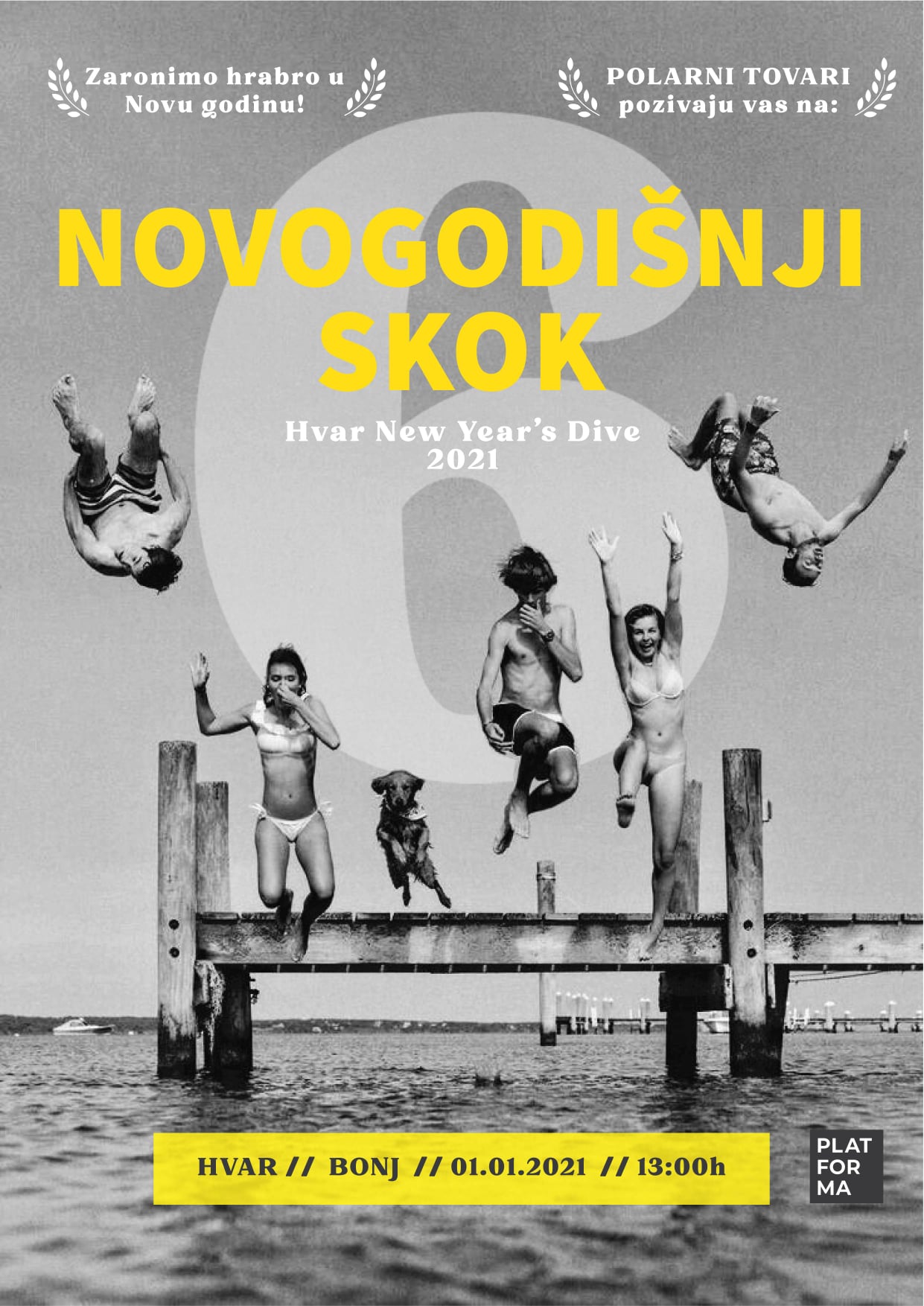
At 13:00 today, the sixth edition of the now traditional New Year's Day swim on the island of Hvar took place once more, organised by the organisation known as Polarni Tovori (the Polar Donkeys).
The annual swim, which takes place at fashionable Bonj les Bains, the historical 1930s colonnade in front of Hotel Amfora, was well attended again by both humans and the occasional four-legged friend.
With water temperatures of 16 degrees, the water was inviting for the brave-hearted.
A refreshing swim, and a chance to forget the horrors of 2020 and to look forward to another wonderful summer on Croatia's premier island.
You can get a flavour of today's action in the video below.
To follow the latest news from the island of Hvar in 2021, follow the dedicated TCN section.
Learning Croatian: The Months of the Year v Hvar Dialect
December 27, 2020 - Continuing our look at the Croatian language through the unique viewpoint of Professor Frank John Dubokovich, Guardian of the Hvar Dialects, time to learn the months of the year.
One of the many things that baffled me when learning Croatian during my time in Jelsa were the months of the year.
With every language I have learned (or perhaps, more accurately, attempted to learn), the days of the week and months of the year were usually one of the earliest - and easiest - things to master.
Not so with Croatian, or should I say the version of Croatian I was exposed to.
And it seemed that I was not alone, and that locals seemed to get a little confused too. At first I thought it was due to the fact that the use of the months of the year in modern Croatian were being deliberately used to move away from Serbo-Croat, in the same way that 'aerodrom' was replaced by 'zracna luka' (literally 'air harbour'), and there were wonderful Croatian versions of Serbo-Croatia - listopad (leaves falling) rather than Oktober being my favourite.
But over time, I realised that it was just the way that people speak here, especially in dialect. Rather than refer to June by its real name, I would often here 'sesti mjesec' or 'sixth month.'
My experience of learning Croatia was hardly classical Croatian grammar at its finest. My main teacher was a man in my local cafe, who went on to become christened Professor Frank John Dubokovich, Guardian of the Hvar Dialects. The Professor's iconic Dalmatian Grunt, above, amassed 50,000 views on YouTube back in 2013 and inspired an alternative language series with the Professor's teachings, which was mysteriously removed by YouTube a few years ago.
I chanced upon some of the original footage recently, and so I am posting the lessons once more, in the hope that the Professor can inspire a new generation. Today, we look at the months of the year, comparing the months of the year in standard Croatia and Hvar dialect. Did the Professor simply run out of words, or do you think he was demonstrating his prowess at counting?
You can follow more of the Professor's linguistic genius on our YouTube channel.


